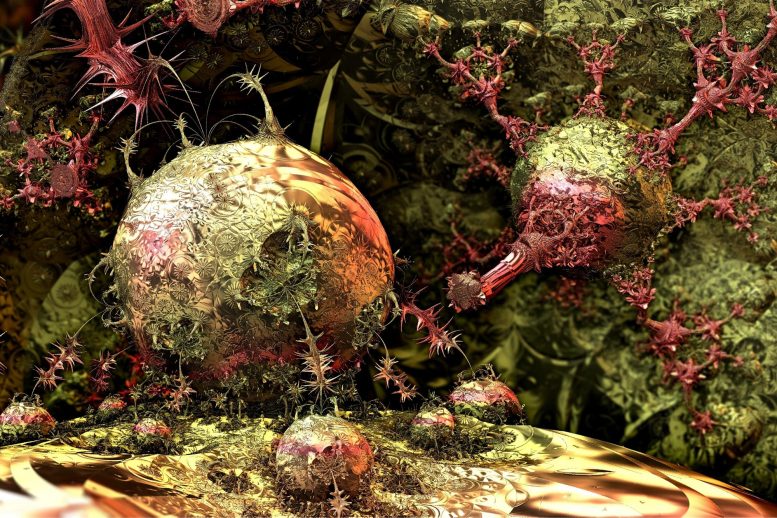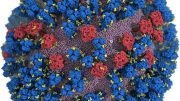
Cancer Cells Artistic Rendering
While using zebrafish for their research, a newly published study from Massachusetts General Hospital suggests that tumor-propagating cells aren’t always the first colonizing cells that travel from the primary tumor to start the process of local invasion and metastasis.
A study from Massachusetts General Hospital (MGH) researchers suggests that specific populations of tumor cells have different roles in the process by which tumors make new copies of themselves and grow. In their report in the May 15 issue of Cancer Cell, researchers identify a tumor-propagating cell required for the growth of a pediatric muscle tumor in a zebrafish model and also show that another, more-differentiated tumor cell must first travel to sites of new tumor growth to prepare an environment that supports metastatic growth.
“Most investigators have thought that tumor-propagating cells – what are sometimes called cancer stem cells – must be the first colonizing cells that travel from the primary tumor to start the process of local invasion and metastasis, but in this model, this is simply not the case,” says David Langenau, PhD, of the MGH Department of Pathology and Center for Cancer Research, who led the study. “Instead, the colonizing cells lack the ability to divide and instead prime newly infiltrated regions for the eventual recruitment of slow-moving cancer stem cells. It will be important to test how broadly this phenomenon is found in a diversity of animal and human cancers.”
Langenau’s team has long been using zebrafish to study rhabdomyosarcoma (RMS), an aggressive pediatric cancer. In embryonic zebrafish, RMS can develop within 10 days, and since the tiny fish are transparent at that stage, fluorescent markers attached to particular cellular proteins can easily be imaged. The current study used these properties to monitor how specific populations of tumor cells develop and their role in initiating new tumor growth.
Previous research from the MGH team had discovered that RMS cells expressing marker proteins also seen on muscle progenitor cells had significantly more tumor-propagating potential than did other tumor cells. Fluorescently labeling proteins associated with different stages of cellular differentiation revealed distinct populations of RMS cells in the zebrafish model. Cells expressing the progenitor cell marker myf5, were labeled green, and those expressing myogenin, a marker of mature muscle cells, were labeled red.
In a series of experiments, the research team confirmed that myf5-expressing RMS cells had powerful tumor-propagating potential, but the ability to visualize how tumor cells move in living fish produced a surprising observation. While myf5-expressing cells largely remained within the primary tumor itself, myogenin-expressing RMS cells easily moved out from the tumor, entering the vascular system and passing through usually impenetrable layers of collagen. Only after the more-differentiated but non-proliferative myogenin-expressing cells had colonized an area did the myf5-expressing tumor-propagating cells appear and start the growth of a new tumor. Imaging the labeled tumor cells also revealed that different cellular populations tended to cluster in different areas of later-stage tumors.
“Our direct in-vivo imaging studies are the first to suggest such diverse cellular functions in solid tumors, based on differentiation and the propensity for self-renewal,” says Myron Ignatius, PhD, of MGH Pathology and Center for Cancer Research, the study’s first author. “I think we will find that this kind of division of labor is a common theme in cancer, especially given that the vast majority of cells within a tumor are not tumor-propagating cells. We suspect there will be molecularly defined populations that make niches for tumor-propagating cells, secrete factors to recruit vasculature, and create boundaries to suppress immune cell invasion.”
Langenau adds, “Division of labor is a new and emerging concept in cancer research that we hope will lead to new targets for rationally designed therapies. In rhabdomyosarcoma it will be important to target both the tumor-propagating cells and the highly migratory colonizing cells for destruction – a major focus of ongoing studies in our group.” Langenau is an assistant professor of Genetics at Harvard Medical School and a principal faculty member at the Harvard Stem Cell Institute.
Reference: “In Vivo Imaging of Tumor-Propagating Cells, Regional Tumor Heterogeneity, and Dynamic Cell Movements in Embryonal Rhabdomyosarcoma” by Myron S. Ignatius, Eleanor Chen, Natalie M. Elpek, Adam Z. Fuller, Inês M. Tenente, Ryan Clagg, Sali Liu, Jessica S. Blackburn, Corinne M. Linardic, Andrew E. Rosenberg, Petur G. Nielsen, Thorsten R. Mempel and David M. Langenau, 15 May 2012, Cancer Cell.
DOI: 10.1016/j.ccr.2012.03.043
Additional co-authors author of the Cancer Cell article are Eleanor Chen, Adam Fuller, Ines Tenente Rayn Clagg, Sali Liu, Jessica Blackburn, MGH Pathology and Center for Cancer Research; Andrew Rosenberg, and Petur Neilsen, MGH Pathology; Natalie Elpek and Thorsten Mempel, MGH Center for Immunology and Inflammatory Diseases; and Corinne Linardic, Duke University Medical Center. The study was supported by grants from the National Institute of Health, the Alex’s Lemonade Stand Foundation, the Sarcoma Foundation of America, the American Cancer Society and the Harvard Stem Cell Institute.









A little later it is proved by Massachusettes Institute of Technology findings (Oct 2012) that Metastasis is promoted by our own branch of stem cells like MSCs (Messenchymal Stem Cells). Instead of becoming guardians to produce immune cells they change their task to become villains and start nourishing tumour cells and help its proliferation . This is analagous to stem cell therapy where stem cells taken from bone marrow when injected to diseased liver or heart start producing healthy cells of the organ concerned. These pluripotent stem cells are innocent and their only task is to identify themselves to the place of posting and do the task both good and bad depending on the nature of the host cells. Left alone only they do their prescribed task of forming immune cells.Research in this direction is more promising indeed to finally conquer the concer by understanding cancer biology. Thank You.